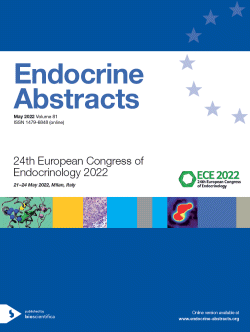
European Congress of Endocrinology 2022
Milan,
Italy
21 May 2022 - 24 May 2022

Poster Presentations
Environmental Endocrinology
ea0081p134 | Environmental Endocrinology | ECE2022
Autoimmune polyglandular syndromes in childhood: casuistic of a pediatric unit
Bouca Bruno , Nogueira Andreia , Caetano Joana , Cardoso Rita , Dinis Isabel , Mirante Alice
ea0081p135 | Environmental Endocrinology | ECE2022
Effects of decamethylcyclopentasiloxane by maternal exposure on the offspring mice behaviors
Jeung Eui-Bae , Yi Donglin , Kim KangMin , Lee Minsu , Lee Jimin , Kim YongIn
ea0081p136 | Environmental Endocrinology | ECE2022
Orbital inflammatory disease following mrna sars-cov-2 vaccine: a case report
Solange Grunenwald , Lethellier Gabriel , Imbert Philippe , Dekeister Celine , Caron Philippe
ea0081p137 | Environmental Endocrinology | ECE2022
Di-butyl phthalate exposure in a human adrenocortical cell line impairs steroid hormone synthesis
Kallsten Liselott , Pierozan Paula , W Martin Jonathan , Karlsson Oskar
ea0081p392 | Environmental Endocrinology | ECE2022
A cell-based platform to screen chemical mixtures for endocrine disruptive effects
Strand Denise , Nylander Erik , Lundgren Bo , W Martin Jonathan , Karlsson Oskar
ea0081p393 | Environmental Endocrinology | ECE2022
Dioxin-like polychlorinated biphenyl (pcbs) congeners induce inflammatory responses and reduce thyroid-specific genes expression in human thyrocytes via ahr pathways
Ruggeri Rosaria , Minuti Aurelio , Aliquo Federica , Giani Fiorenza , Masto Roberta , Romano Davide , Avenoso Angela , Teresa Cristani Maria , Trimarchi Francesco , Campenni Alfredo , D'Ascola Angela , Cannavo Salvatore
ea0081p394 | Environmental Endocrinology | ECE2022
Synergism between bisphenol a exposure and overweight/obesity in increasing the malignancy risk in a cohort of patients with thyroid nodules
Marotta Vincenzo , Grumetto Lucia , Neri Ilaria , Russo Giacomo , Tortora Anna , Izzo Giulia , Rocco Domenico , Vitale Mario
ea0081p395 | Environmental Endocrinology | ECE2022
The endocrine disruptor cadmium affects both ERα+ and ERα- breast cancer cell lines
Maria Bimonte Viviana , Sabato Claudia , Trocchianesi Sofia , Mersini Besharat Zein , Po Agnese , catanzaro giuseppina , Falcone Italia , Fabi Alessandra , Bei Roberto , Milella Michele , Vacca Alessandra , Ferretti Elisabetta , Migliaccio Silvia
ea0081p649 | Environmental Endocrinology | ECE2022
Neonatal thyroid stimulating hormone as indicator of Iodine status in Lithuania
Zabuliene Lina , Miglinas Marius , Brazdziunaite Deimante , Smirnova Marija , Songailiene Jurgita , Bratcikoviene Nomeda , Banys Valdas , Macioniene Ernesta , Utkus Algirdas
ea0081p650 | Environmental Endocrinology | ECE2022
Potential synergic and antagonistic effects of EDC mixtures on human prostate cells
Mileo Aldo , Riccio Lorenzo , Francesco Di Tolla Michele , D'Esposito Vittoria , Chianese Teresa , Laforgia Vincenza , Formisano Pietro , De Falco Maria
ea0081p651 | Environmental Endocrinology | ECE2022
Di-(2-ethylhexyl) phthalate decreases forskolin-stimulated progesterone synthesis in human granulosa cells
Samardzija Nenadov Dragana , Tesic Biljana , Andric Nebojsa , Pogrmic-Majkic Kristina



